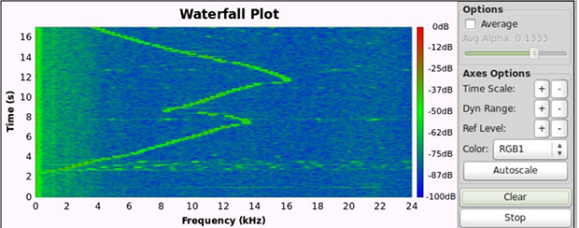Say you’ve got a neat gadget you are building. You need to send data to it, but you want to keep it simple. You could add a WiFi interface, but that sucks up power. Bluetooth Low Energy uses less power, but it can get complicated, and it’s overkill if you are just looking to send a small amount of data. If your device has a microphone, there is another way that you might not have considered: ultrasonic communications. Continue reading “Hackaday Dictionary: Ultrasonic Communications”
gnu radio35 Articles
GNU Radio Drives Oscilloscope
These days we are spoiled with a lot of cheap test equipment. However, you can do a lot of measurements with nothing more than an oscilloscope. Add something like a signal generator and you can do even more. One classic technique for frequency measurement, for example, is using a scope to display a Lissajous pattern. [Franz Schaefer] has a video showing how to generate these useful curves with GNU Radio.
As we pointed out earlier, GNU Radio doesn’t have to be about radio–it is really just a Python-based signal processing laboratory. [Franz] uses GNU Radio Companion to create blocks which in turn create the patterns on an old analog scope.
Improving WiFi Throughput With FM Radio
WiFi networking is one of those things that is reasonably simple to use, but has a lot of complex hidden features (dare we say, hacks) that make it work, or work better. For example, consider the Distributed Coordination Function (DCF) specified in the standard. Before a station can send, it has to listen for a certain time period. If the channel is clear, the station sends. If not, it has to delay a random amount of time before trying again. This is a form of Carrier Sense Multiple Access (CSMA) channel management.
Unfortunately, listening time is dead time when–at least potentially–there is no data transmitted on the network. DCF allows you to use various handshaking packets to do virtual carrier detection and ready/clear to send, but these are also less efficient use of bandwidth. There are other optional coordination functions available in the WiFi standard, but they all have their drawbacks.
[Aleksandar Kuzmanovic] at Northwestern University and two of his students have recently published a paper with a new way to coordinate multiple unrelated wireless networks using ubiquitous FM broadcast radio signals called WiFM. Instead of trying to synchronize to the WiFi data channel, this new scheme selects a strong FM radio station that broadcasts Radio Data Service (RDS) data (the data that populates the song titles and other information on modern radios).
Getting Started With GNU Radio
Software Defined Radio (SDR)–the ability to process radio signals using software instead of electronics–is undeniably fascinating. However, there is a big gap from being able to use off-the-shelf SDR software and writing your own. After all, SDRs require lots of digital signal processing (DSP) at high speeds.
Not many people could build a modern PC from scratch, but nearly anyone can get a motherboard, some I/O cards, a power supply, and a case and put together a custom system. That’s the idea behind GNU Radio and SDR. GNU Radio provides a wealth of Python functions that you can use to create sophisticated SDR application (or, indeed, any DSP application).
If Python is still not up your alley (or even if it is), there’s an even easier way to use GNU Radio: The GNU Radio Companion (GRC). This is a mostly graphical approach, allowing you to thread together modules graphically and build simple GUIs to control you new radio.
Even though you usually think of GRC as being about radios, it is actually a good framework for building any kind of DSP application, and that’s what I’ll show you in the video below. GRC has a signal generator block and interfaces to your sound card. It even has the ability to read and write data to the file system, so you can use it to do many DSP applications or simulations with no additional hardware.
UPDATE: Don’t miss the follow-up post that uses SDRPlay to build a GNU Radio based receiver.
Mid-Priced Hardware Gets Serious About Software Defined Radio
Regular Hackaday readers are used to seeing the hacks that use a cheap USB TV dongle as a software defined radio (SDR). There’s plenty of software that will work with them including the excellent GNU Radio software. However, the hardware is pretty bare-bones. Without modifications, the USB dongle won’t get lower frequencies.
There’s been plenty of other SDR radios available but they’ve had a much heftier price tag. But we recently noticed the SDRPlay RSP, and they now have US distribution. The manufacturer says it will receive signals with 12-bits of resolution over the range of 100 kHz to 2 GHz with an 8MHz bandwidth. The USB cable supplies power and a connection to the PC. The best part? An open API that supports Windows, Linux, Mac, Android, and will even work on a Raspberry Pi (and has GNU Radio support, too).
Continue reading “Mid-Priced Hardware Gets Serious About Software Defined Radio”
[Balint]’s GNU Radio Tutorials

[Balint] has a bit of history in dealing with software defined radios and cheap USB TV tuners turned into what would have been very expensive hardware a few years ago. Now [Balint] is finally posting a few really great GNU Radio tutorials, aimed at getting software defined radio beginners up and running with some of the coolest hardware around today.
[Balint] is well-known around these parts for being the first person to create a GNU Radio source block for the implausibly inexpensive USB TV tuners, allowing anyone with $20 and enough patience to wait for a package from China to listen in on everything from 22 to 2200 MHz. There’s a lot of interesting stuff happening in that band, including the ACARS messages between airliners and traffic control, something that allowed [Balint] to play air traffic controller with a minimal amount of hardware.
Right now the tutorials are geared towards the absolute beginner, starting at the beginning with getting GNU Radio up and running. From there the tutorials continue to receiving FM radio, and with a small hardware investment, even transmitting over multiple frequencies.
It’s not much of an understatement to say software defined radio is one of the most versatile and fun projects out there. [Balint] even demonstrated triggering restaurant pagers with a simple SDR project, a fun project that is sure to annoy his coworkers.
Hacking Rolling Code Keyfobs
Most keyfobs out there that open cars, garage doors, and gates use a rolling code for security. This works by transmitting a different key every time you press the button. If the keys line up, the signal is considered legitimate and the door opens.
[Spencer] took a look into hacking rolling code keyfobs using low cost software-defined radio equipment. There’s two pars of this attack. The first involves jamming the frequency the keyfob transmits on while recording using a RTL-SDR dongle. The jamming signal prevents the receiver from acknowledging the request, but it can be filtered out using GNU Radio to recover the key.
Since the receiver hasn’t seen this key yet, it will still be valid. By replaying the key, the receiver can be tricked. To pull off the replay, GNU Radio was used to demodulate the amplitude shift keying (ASK) signal used by the transmitter. This was played out of a computer sound card into a ASK transmitter module, which sent out a valid key.

















